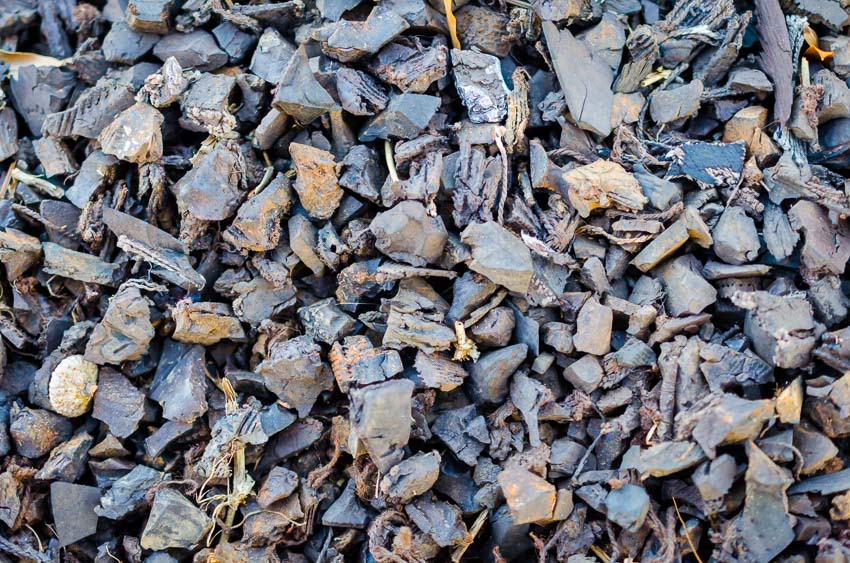Rubber mulch looks good and is a great way to recycle tires. As a mulch, rubber is highly effective and has a lot of advantages, but there is some controversy about how safe it is for people and the environment. Therefore, it’s helpful to understand the pros and cons of rubber mulch before making your decision.
What is Rubber Mulch?
Rubber mulch is made from recycled tires. According to the Environmental Protection Agency , over 290 million tires are scrapped each year, representing about 2% of all solid waste generated in the United States.
You can use recycled rubber as fuel, export it to other countries, and use it in civil engineering projects like roads and athletic fields. But there is still a surplus.
Stockpiles of scrapped tires present several threats to our environment, and finding safe ways to use them is critical. Rubber mulch is used like wood mulch to suppress weeds and protect plants from heat and moisture loss.
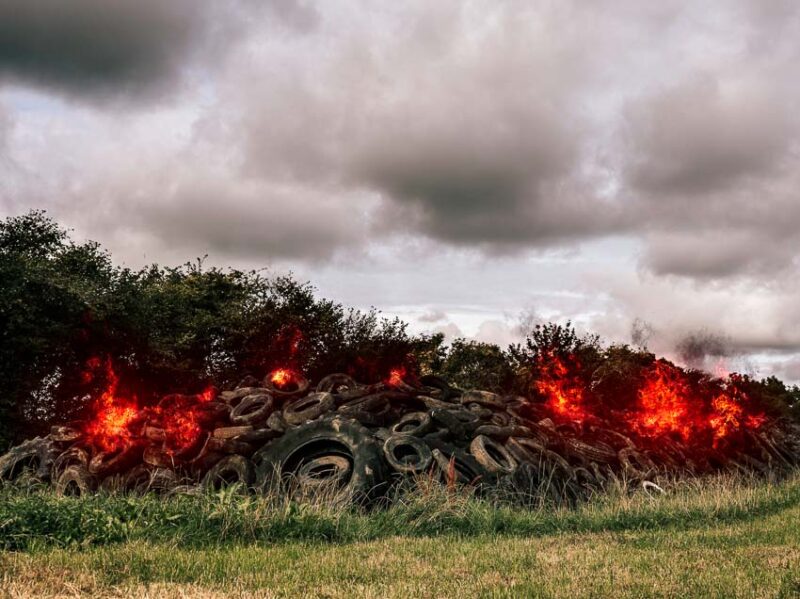
Because it is soft and cushiony, rubber mulch is commonly used on playgrounds and as filler in artificial grass.
There are several benefits to using rubber mulch.
It’s impermeable to water, unlike wood mulch which absorbs water so it won’t float away during hard rains. More moisture will make it to your plants, and it has a higher insulating value than wood. That way, your plants can enjoy cooler soil in the hot summer.
Furthermore, rubber mulch doesn’t attract pests like termites and carpenter ants. And it lasts much longer than wood mulch because it doesn’t break down as quickly.
Make-up of Rubber Mulch
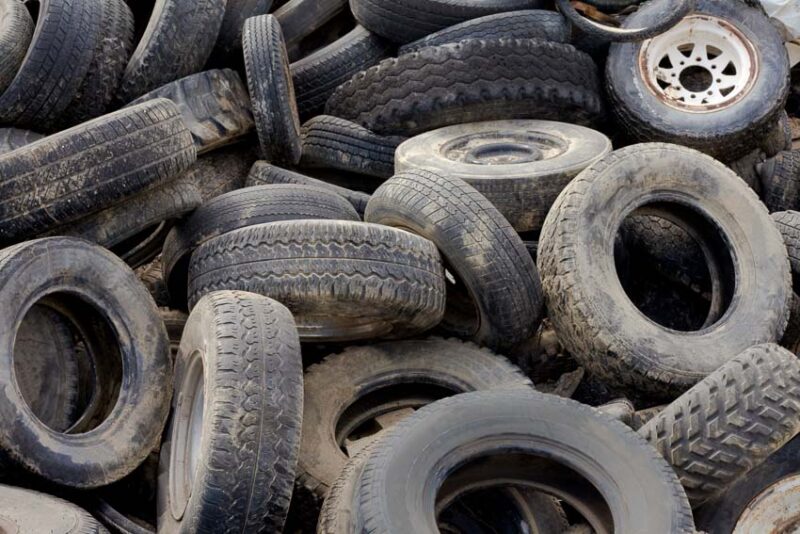
Rubber mulch comes from recycled rubber, mostly tires, but sometimes from recycled playground safety tiles and old sneaker soles. Some types of rubber mulch are coated with high-quality paint that makes them more aesthetically pleasing.
There are different types of rubber mulch on the market, including rubber tire mulch, comprised of unpainted pieces of shredded tires in various shades of black and grey. Colored rubber landscape mulch, which gets its color from a protective coating is often used as landscaping mulch and on playgrounds.
Production Process of Rubber Mulch
Turning old tires into rubber landscape mulch is a process that requires a lot of shredding, grinding, and sorting. The rubber mulch production process starts with old tires of all types.
In preparation to go through the grinder, manufacturers strip off the valve stems. Then they grind the tires into smaller pieces in huge grinding machines.
After the grinder, they send the rubber through a shredder, which cuts the rubber into various sizes, including mulch-sized pieces. After that, they remove the metal so the shredded rubber can be processed on conveyer belts with super-powerful magnets that remove 99.9% of the metal.
The tiny pieces of steel that this magnetically extracts from the shredded tires also get recycled.
After they remove the metal, rubber mulch is ready for color. They paint it in various colors, including blacks, browns, reds, and blues.
The most popular colors for landscaping are earth tones and red rubber mulch. Rubber mulch color is guaranteed to last 10 to 12 years.
Once they paint the rubber mulch, it’s ready for bagging. Most rubber landscape mulch is sold to consumers in 0.8 cubic feet bags that they can purchase at garden centers and home improvement stores.
You can also purchase large super-sacks containing over 75 cubic feet of rubber mulch.
Types of Rubber Mulch
There are many different rubber mulch manufacturers, and their products are similar. Therefore, it can take time to decide which one is best for your purpose.
Learn more about the different kinds of rubber mulch, color variations, and ideal locations for use.
Exploring the Different Kinds of Rubber Mulch
When discussing the pros and cons of rubber mulch, one of the most significant distinctions is the variations in color.
How they process rubber mulch is another important factor. Large pieces that look like shredded bits of tire–which cost less–are different from color-coated nuggets that provide superior performance and visual appeal.
Varieties Based on Color and Size
Rubber mulch nuggets come in various sizes, from ⅜” to 1¼” (10 mm to 32 mm). Some manufacturers use large truck tires to make rubber mulch, which creates a superior product that looks less like shredded tires. But generally, the smaller the bits of rubber mulch, the less they resemble pieces of tire.
It’s a lot like the difference between shredded bark and bark nuggets.
Rubber mulch comes in a variety of colors, and homeowners who want to break away from earth tones can experiment with brighter colors. Colors like blues and greens, which aren’t traditional mulch colors, look great with the clean lines of white accents on homes.
Whatever color you decide on, one of the biggest benefits of rubber mulch is that it holds its color for about ten years. That means you don’t have to keep reapplying it to keep your yard looking fresh.
Here are the most common colors of rubber mulch:
| Rubber mulch color | Pros and cons |
| Unpainted black and grey | Unpainted black mulch is less expensive but looks like shredded tires. On the other hand, it absorbs heat, so there may be better choices for playgrounds in hot areas. |
| Black rubber mulch | Black rubber mulch is perfect for making the colors in your yard pop. Even though it absorbs a lot of heat, it will keep your plant’s roots cool. |
| Dark brown rubber mulch | Dark brown is one of the most realistic rubber mulch color choices. It looks like real wood mulch for a natural aesthetic. |
| Cypress rubber mulch | Cypress rubber mulch is another nature-inspired color that creates an earthy look. |
| Red rubber mulch | One of the most popular colors, it accents playground equipment in commercial and residential settings, and it looks like natural red-colored wood mulch in your flower beds |
| Green rubber mulch | Green is a natural color, and even though it’s not a traditional color for mulch, it still looks good in your yard. It’s also great for municipal playgrounds and backyard play areas because it resembles grass. |
| Blue rubber mulch | Like red and green rubber mulch, blue is a popular choice for playgrounds, and it’s also a fun way to add color to borders and flower beds in your yard. |
Ideal Locations for the Use of Rubber Mulch
There are a few top uses for rubber mulch, and as it becomes more popular, it will inspire people to use it in other areas. Of course, it’s most often used in landscaping and creating safe play surfaces for children’s playgrounds, but there are a few other locations where it’s gaining popularity over wood mulch.
Rubber Mulch in Gardens
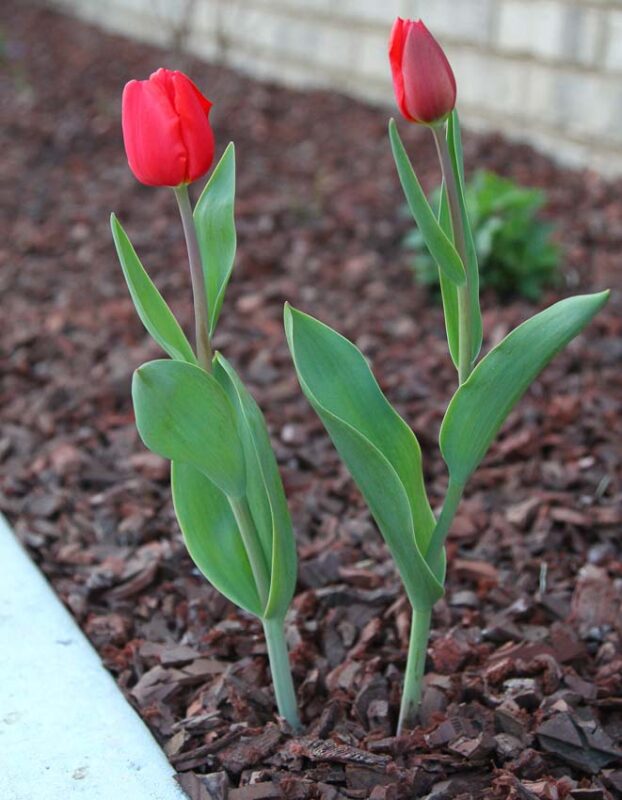
Rubber mulch has several advantages when used in gardens and landscaping. It comes in a variety of colors that will accent your home. Unlike wood mulch, which loses its color in a few months, rubber mulch holds its color for years.
Many people want to know how much rubber mulch they need for their projects. In determining the pros and cons of rubber mulch, one of the pros is that rubber mulch is heavier than wood. That means it won’t float, so you don’t have to use as much of it.
While some types of mulch need to be a few inches thick, rubber mulch only needs to be about 1.5 inches thick.
There is some controversy about how many chemicals leach into the ground from rubber mulch. So, you shouldn’t use it in your vegetable garden, but it’s safe for shrubs, trees, and flower gardens.
Rubber Mulch in Playgrounds
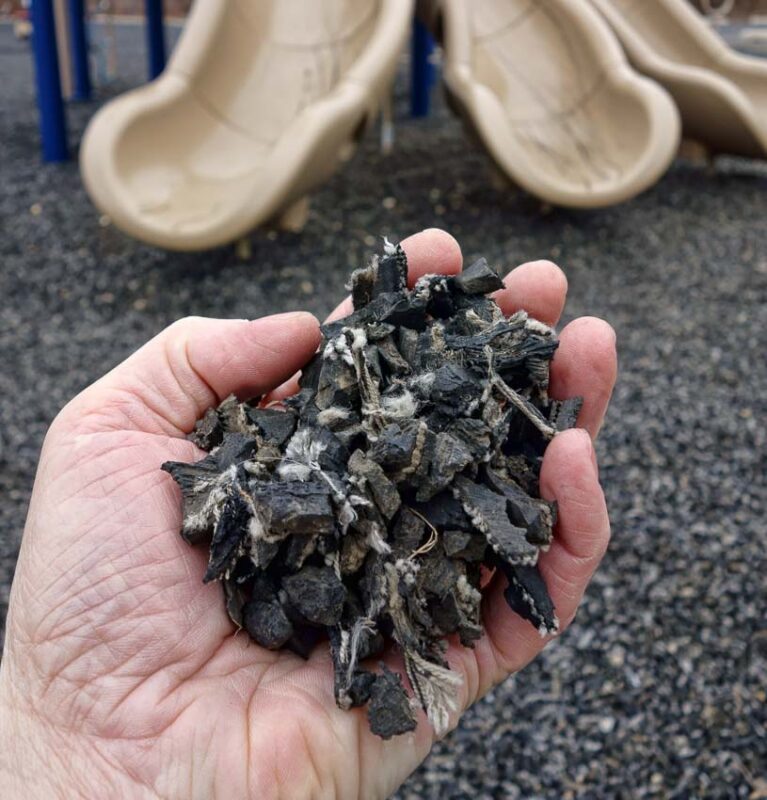
Another distinction between the pros and cons of rubber mulch is that rubber can replace wood and pebbles in many playgrounds because it’s soft and provides cushion for falls. Since it comes in many attractive colors, it’s ideal for play areas in your yard. Furthermore, you commonly see it in municipal playgrounds.
Generally, you should lay rubber mulch 6 inches thick for playgrounds, but for your backyard play areas, 3 inches is adequate.
You can also mix rubber mulch with an aromatic binder to create a strong yet soft play surface for children. You can mix this polyurethane glue with rubber mulch in a cement mixer at home to create a bonded playground surface that will look great for years.
Other Uses of Rubber Mulch
There are other uses for rubber mulch. In fact, it’s replacing various products in common applications like equestrian arenas, military training areas, and artificial turf infill.
Equestrian Arenas
Used in horse arenas, rubber mulch provides a soft, dust-free mulch that doesn’t make a mess.
The springiness of rubber mulch is easier on riders and horses, and the shock-absorbency also makes falls safer. In addition, caring for an equestrian arena is easier with rubber mulch because it requires less smoothing. Moreover, you don’t need to water it down to prevent dust.
Military Training Areas
As a military training area surface, rubber mulch provides a safe, shock-absorbent, and skid-proof material for obstacle courses, ropes courses, and shooting ranges. You don’t have to replace it as often because it doesn’t break down as quickly as wood.
It works great for shooting ranges because the absorbent nature of rubber prevents ricochets.
Artificial Grass Infill
Rubber crumb infill for artificial grass is a popular choice because it doesn’t decay, and it can be painted green to add color and make your artificial turf look thicker. As infills go, rubber is one of the best options because it is soft and cushiony, doesn’t absorb water or pet urine, and doesn’t attract insects.
Reasons to Choose Rubber Mulch Over Other Types of Mulch
An additional aspect of the pros and cons of rubber mulch is that rubber mulch is long-lasting. And even though you might pay more upfront, you will save money in the long run.
Here are some of the best reasons to choose rubber mulch over other types of mulch.
Rubber Mulch vs Wood Mulch
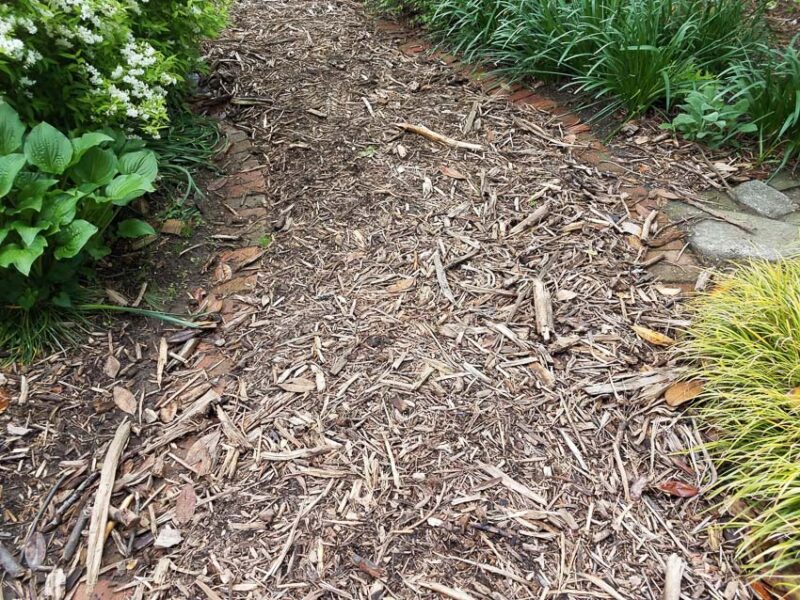
One of the most common complaints about wood mulch is that it floats away during heavy rains or watering. Of course, it’s no surprise that wood floats, but it might surprise you to know that rubber mulch weighs about twice as much as wood. As such, it stays where you put it.
Rubber mulch also doesn’t attract carpenter ants and termites like wood mulch.
Wood mulch must be installed yearly to keep it looking fresh, but since rubber mulch will hold its color for about ten years, you can save money on product and installation costs.
Rubber Mulch vs Stone Mulch
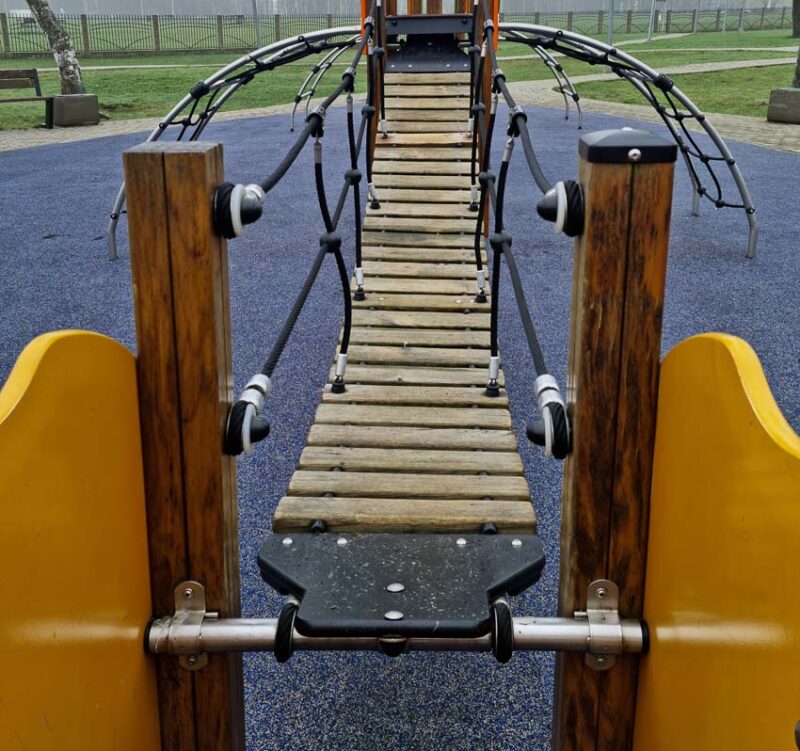
Both rubber and stone mulch are durable materials that work equally well in the garden. They both stay put and keep their color, and whether you choose rock or rubber mulch, it’s a matter of personal taste.
Rubber works better than stone mulch in children’s play areas.
Frequently Asked Questions (FAQs) about Rubber Mulch
Is Rubber Mulch Safe for Plants?
Rubber mulch is safe for landscaping and use around plants in your flower beds. However, rubber mulch contains many chemicals.
While the EPA has approved it, there is still some controversy about how safe it is for plants.
How Long Does Rubber Mulch Last?
According to most rubber mulch manufacturers, rubber mulch lasts 10 to 12 years before the color starts to fade. Many online reviews of rubber mulch support that claim.
Can Rubber Mulch Be Used in Vegetable Gardens?
Most people don’t recommend rubber mulch for use in your vegetable garden because it may release harmful chemicals that plants can absorb. The best option for gardens is to use an organic mulch that breaks down quickly and amends the structure of your soil, and it costs much less.
Does Rubber Mulch Attract Insects?
Rubber mulch does not attract insects, mice, or other pests. For example, carpenter ants and termites can appear out of nowhere when you use wood mulch, but that doesn’t happen with rubber mulch.
Is Rubber Mulch Environmentally Friendly?
While some people complain that rubber mulch can leach chemicals, it’s a great use for old tires, which are a significant problem. Even though old tires are no longer being put in landfills, the stockpiles can leach chemicals and sometimes catch on fire.

